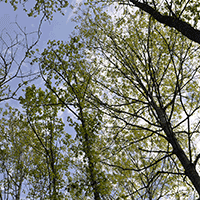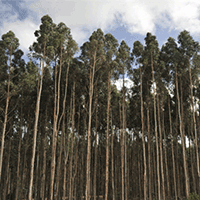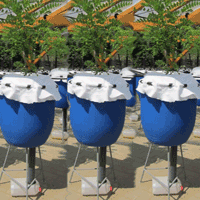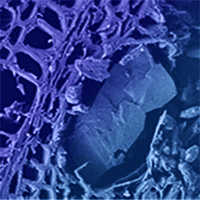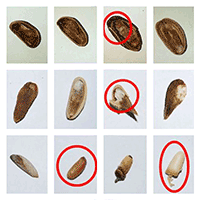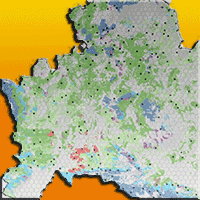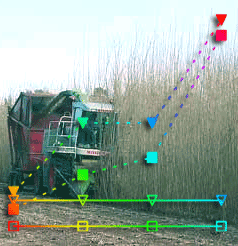
Biomass production of Populus nigra L. clones grown in short rotation coppice systems in three different environments over four rotations
Vojtech Benetka, Katerina Novotná, Petra Štochlová
iForest - Biogeosciences and Forestry, Volume 7, Issue 4, Pages 233-239 (2014)
doi: https://doi.org/10.3832/ifor1162-007
Published: Mar 10, 2014 - Copyright © 2014 SISEF
Research Articles
Abstract
Three clones of black poplar and a hybrid poplar clone, “NE-42”, were trialled in a short rotation coppice system. The trial was replicated in three sites located in the Czech Republic with distinctly different soils and climates which were judged to be respectively favorable, unfavorable and marginal for growing black poplar. In the marginal and unfavorable sites the planting density was 2222 trees ha-1 and in optimal conditions 7407 trees ha-1. The aim of the trial was: (1) to test the performance of black poplar clones as a possible replacement for commercial hybrid poplars in areas where the genetic integrity of wild black poplar populations is under threat; (2) to test the range of conditions in which it is possible to grow black poplar and its suitability for utilizing marginal agricultural land; and (3) to measure the potential yield of black poplar clones grown in these conditions. During four harvests at three-year intervals, the following parameters were measured: plant mortality, number of shoots, thickness of shoots, the total cross-sectional area (TCA) of all shoots, the dry matter weight of individual plants (DMIP) and the dry matter yields per hectare. The differences observed between “NE-42” and the best black poplar clone decreased as conditions became more favorable. During the fourth harvest at the unfavorable site for growing poplars, the yield of dry biomass was 11.7 t ha-1 yr-1 for “NE-42” compared to 3.7 t ha-1 yr-1 for the best black poplar clone. In marginal conditions the yields were 11.8 and 9.9 t ha-1 yr-1 respectively, and in the favorable conditions there was no statistically significant difference, being 15.9 and 13.2 t ha-1 yr-1, respectively. The higher yield of “NE-42” was due to the higher proportion of thicker shoots or, alternatively, lower plant mortality. The observed TCA was highly correlated with DMIP (rs = 0.87) and dry biomass yield (rs = 0.48). It was demonstrated that black poplar can be successfully grown in marginal conditions on land which otherwise would not be especially suitable for agricultural production, and also in areas where the genetic purity of native populations of black poplar is threatened by the spread of commercially grown hybrid poplars.
Keywords
Growing Conditions, Fast-growing Trees, NE-42, Number of Shoots, Stool Mortality, Yield
Authors’ Info
Authors’ address
Katerina Novotná
Petra Štochlová
Silva Tarouca Research Institute for Landscape and Ornamental Gardening, Publ. Res. Inst., Kvetnové námestí 391, CZ-252 43 Pruhonice (Czech Republic)
Corresponding author
Paper Info
Citation
Benetka V, Novotná K, Štochlová P (2014). Biomass production of Populus nigra L. clones grown in short rotation coppice systems in three different environments over four rotations. iForest 7: 233-239. - doi: 10.3832/ifor1162-007
Academic Editor
Gianfranco Minotta
Paper history
Received: Oct 23, 2013
Accepted: Dec 19, 2013
First online: Mar 10, 2014
Publication Date: Aug 01, 2014
Publication Time: 2.70 months
Copyright Information
© SISEF - The Italian Society of Silviculture and Forest Ecology 2014
Open Access
This article is distributed under the terms of the Creative Commons Attribution-Non Commercial 4.0 International (https://creativecommons.org/licenses/by-nc/4.0/), which permits unrestricted use, distribution, and reproduction in any medium, provided you give appropriate credit to the original author(s) and the source, provide a link to the Creative Commons license, and indicate if changes were made.
Web Metrics
Breakdown by View Type
Article Usage
Total Article Views: 53201
(from publication date up to now)
Breakdown by View Type
HTML Page Views: 43447
Abstract Page Views: 3577
PDF Downloads: 4693
Citation/Reference Downloads: 40
XML Downloads: 1444
Web Metrics
Days since publication: 4302
Overall contacts: 53201
Avg. contacts per week: 86.57
Citation Metrics
Article Citations
Article citations are based on data periodically collected from the Clarivate Web of Science web site
(last update: Mar 2025)
Total number of cites (since 2014): 31
Average cites per year: 2.58
Publication Metrics
by Dimensions ©
Articles citing this article
List of the papers citing this article based on CrossRef Cited-by.
References
Stump sprouting of oak species in three silvicultural treatments in the southern Appalachians. In: Proceedings of the “16th Central Hardwoods Forest Conference” (Jacobs DF, Michler CH eds). West Lafayette (Indiana, USA) 8-9 April 2008, pp. 2-7.
Gscholar
Introgression in black poplar (Populus nigra L. ssp. nigra) and its transmission. Journal of Forest Science 48: 115-120.
Gscholar
Effect of Melampsora larici-populina on growth and biomass yield of eight clones of Populus nigra. Journal of Forest Science 57: 41-49.
Gscholar
New clones of black poplar (Populus nigra L.) for short station coppice cultures. Acta Pruhoniciana 97: 33-38. [in Czech].
Gscholar
Poplar breeding and selecion strategies. In: “Biology of Populus and its implications for management and conservation” (Stettler RF, Bradshaw Jr HD, Heilman PE, Hinckley TM eds). NRC Research Press, National Research Council of Canada, Ottawa, ON, Canada, pp. 139-158.
Gscholar
The conservation of Populus nigra L. and gene flow with cultivated poplars in Europe. Forest Genetics 2: 135-144.
Gscholar
Poplars and willows in the World. Chapter 2, Working paper IPC/9-2, FAO, Rome, Italy, pp. 134.
Gscholar
Biomass production in a 15-year-old poplar short-rotation coppice culture in Belgium. In: “Aspects of Applied Biology 112: Biomass and Energy Crops IV”. Association of Applied Biologists, Wellesbourne, UK, pp. 99-106.
Gscholar
Assessing environmental impact of short station coppice (SRC) expansion: model definition and preliminary results. Bioenergy Research 5: 621-635.
CrossRef | Gscholar
Poplars and their use in energy. Aktuality RIOG, Pruhonice, Czech Republic, pp. 204. [in Czech]
Gscholar
Specification of growing areas of poplars for landscaping purposes. Ms Research Institute of Ornamental Gardening, Pruhonice, Czech Republic, pp. 140. [in Czech]
Gscholar
Some factors indicative of site quality for Black Cottonwood (Populus trichocarpa Torr. and Gray). Journal of Forestry 55: 578-580.
Gscholar
Natural hybridisation between Populus nigra L. and P. × canadensis Moench. Hybrid offspring competes for niches along the Rhine river in the Netherlands. Tree Genetics and Genomes 4: 663-675.
CrossRef | Gscholar
Populus breeding: from the classical to the genomic approach. In: “Genetics and Genomics of Populus” (Jansson S, Bhalerao RP, Groover AT eds). Plant Genetics and Genomics: Crops and Models, Springer Science + Business Media, vol. 8, pp. 309-342.
Gscholar
Rotation length and repeated harvesting influence Populus coppice production. Research Note NC-350, North Central Experimental Station, USDA Forest Service, St. Paul, MN, USA, pp. 1-4.
Gscholar
Willows: an underestimated resource for environment and society. Forestry Chronicle 77: 281-285.
Gscholar
Biomass and stem volume equations for tree species in Europe. Silva Fennica Monographs 4: 63.
Gscholar


